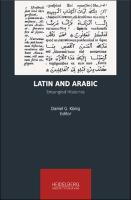Latin and Arabic
Entangled Histories
| dc.contributor.author | König, Daniel G. | |
| dc.date.accessioned | 2020-02-24 10:08:55 | |
| dc.date.accessioned | 2020-04-01T06:50:31Z | |
| dc.date.available | 2020-04-01T06:50:31Z | |
| dc.date.issued | 2019 | |
| dc.identifier | 1007753 | |
| dc.identifier.issn | 2365-7995/eISSN 2365-7987 | |
| dc.identifier.uri | http://library.oapen.org/handle/20.500.12657/22430 | |
| dc.description.abstract | As linguistic systems comprising a large variety of written and oral registers including derivate “languages” and “dialects,” Latin and Arabic have been of paramount importance for the history of the Euromediterranean since Antiquity. Moreover, due to their long-term function as languages of administration, intellectual activity, and religion, they are often regarded as cultural markers of Europe and the (Arabic-)Islamic sphere respectively. This volume explores the many dimensions and ramifications of Latin-Arabic entanglement both from macro-historical as well as from micro-historical perspectives. Visions of history marked by the binary opposition of “Islam” and “the West” tend to ignore these important facets of Euromediterranean entanglement, as do historical studies that explain complex transcultural processes without giving attention to their linguistic dimension. | |
| dc.language | English | |
| dc.relation.ispartofseries | Heidelberg Studies on Transculturality | |
| dc.subject.classification | thema EDItEUR::Q Philosophy and Religion::QR Religion and beliefs::QRA Religion: general::QRAF Interfaith relations | en_US |
| dc.subject.other | Latin | |
| dc.subject.other | Arabic | |
| dc.subject.other | Language | |
| dc.subject.other | Christian-Muslim relations | |
| dc.subject.other | Mediterranean | |
| dc.subject.other | Latein | |
| dc.subject.other | Arabisch | |
| dc.subject.other | Sprache | |
| dc.subject.other | Christlich-Muslimische Beziehungen | |
| dc.subject.other | Mittelmeer | |
| dc.title | Latin and Arabic | |
| dc.title.alternative | Entangled Histories | |
| dc.type | book | |
| oapen.abstract.otherlanguage | Latein und Arabisch haben als Sprachsysteme mit einer großen Vielfalt an schriftlichen und mündlichen Registern, darunter “Sprachen” und Dialekte”, in der Geschichte des Euromediterraneums seit der Antike eine herausragende Rolle gespielt. Aufgrund ihrer lang anhaltenden Funktion als Sprachen der Administration, intellektueller Aktivität und Religion, werden sie oft als kultureller Marker Europas und der arabisch-islamischen Sphäre betrachtet. Dieser Band untersucht die vielen Facetten lateinisch-arabischer Verflechtung aus makro- und mikrohistorischer Perspektive. Er stellt die binäre Opposition von “Islam” und “dem Westen” in Frage und hebt die sprachliche Dimension christlich-muslimischer Beziehungen hervor. | |
| oapen.identifier.doi | 10.17885/heiup.448 | |
| oapen.relation.isPublishedBy | e783d080-4414-442b-9d7e-07b750c7b25d | |
| oapen.relation.isbn | 9783947732258; 9783947732265 | |
| oapen.imprint | heiUP | |
| oapen.series.number | 5 | |
| oapen.pages | 288 | |
| oapen.place.publication | Heidelberg |

